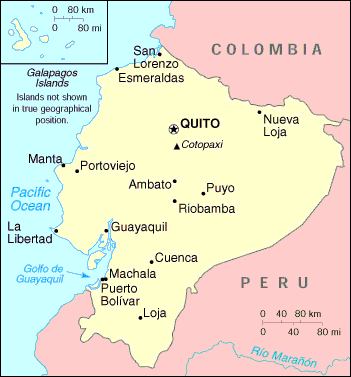

Status Quo Side: USA
Non-Status Quo Side: Ecuador
Region: Western Hemisphere
Conflict Type: Interstate
Issues in Dispute: Resources
Economically underdeveloped Ecuador, lacking an exploitable continental shelf and mindful of the rich fishing potential off its coast, in 1952 along with Peru and Chile claimed a 200-mile territorial limit. The US continued to recognize a 3-mile limit plus, in 1966, a 9-mile contiguous fisheries zone. The so-called "tuna war" began in 1963 when a US fishing boat challenging the 200-mile limit was seized and fined by Ecuador. Other seizures followed, also in Peru and Chile. In 1967 the US began compensating the fined US owners although not deducting the amount from aid to Ecuador as US law provided. In December 1968 US military sales to Ecuador were suspended under a newly-passed law, but renewed in July 1969 despite further seizures. Four-nation talks were held in August 1969 and September 1970. On January 18 1971, with seizures since 1966 totalling 28 vessels, the US again suspended military sales and placed all aid "under review." The OAS opposed U.S. moves to submit the case to inter-American peaceful settlement or the ICJ. On February 1, Ecuador ordered the US military mission withdrawn. By March 3 seizures for 1971 alone totalled 25.
A US freighter 600 miles off Ecuador was stopped by warning shots across its bow from an Ecuadorian warship, but allowed to proceed. An apology was demanded and received, but without explanation. Concurrently the American Tunaboat Association and 12 labor unions attempted a boycott of Ecuadorian ships and products. In 1972, in defiance of the US State Department, the Association bought fishing licenses from Ecuador as the Japanese were doing. A year later, fines outstanding still totalled $4 million.
The US proposed a Pacific "regional association" whereby all members would recognize other members' right to a 200-mile offshore zone for resource conservation. No formal discussions were held but eventually all tuna boat owners purchased licenses.
Most countries have since adopted an "exclusive economic zone" (EEZ) which is now a provision of the UN Law of the Sea treaty. The treaty was signed in 1982 and came into force in 1994 having received 60 ratifications. The 200-mile EEZ is observed by many states that have not signed and/or not ratified the treaty.